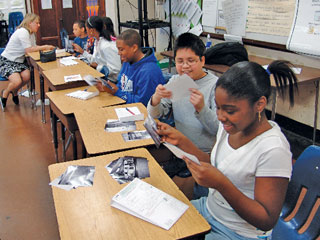Writing With Light
by J. Tim Raymond
CEPA exhibit showcases a partnership in teaching artist instruction

Currently on exhibit at CEPA Gallery is Writing With Light, work by students from three Buffalo public schools—Native American Magnet, Frederick Law Olmsted, and Highgate Heights. Writing with Light is a joint venture between CEPA Gallery and Just Buffalo Literary Center, in which students gain practical experience in the literary and photographic arts.
I met with Karen Lewis and Amy Luraschi, teaching artists representing Just Buffalo and CEPA Gallery respectively, for a tour of this spacious exhibition. Both were gracious and enthusiastic in their willingness to walk me through the process from the initial administrative partnership, to granting agencies groundwork, to initiating the children in the basics of photography and poetry. They offered their responses to the finished photos, and personal narratives worked up in 10-week project sessions, all shoehorned in between the public school years’ rigorous testing schedules and the often unchanneled energies fifth and sixth grade boys and girls.
Lewis, the writing teacher, spoke of getting kids to open up their verbal imaginations and of investing their words with personal meaning in response to the photos they had taken.
Luraschi, from CEPA, spoke of the mixed delight and anxiety the children demonstrated as they were each given a small disposable camera, for which they were responsible for a whole week. She instructed them in the basic concerns of framing the photographic image, emphasizing line, shape, texture, pattern, and perspective, as well as pointing out what to watch for so they did not waste film on “oops pictures,” though even those could produce “happy accidents.”
So now the student had the tools to build a stock of images using the basic elements of design to get more expressive pictures—and to push past the ordinary episodes of the visual field, such as the TV sets, video game screens, all the offhand vacant bits of the average snapshot, to produce something closer to an authentic expression of their own personal lives.
As we moved from room to room in the CEPA gallery, the chosen photos with their accompanying narratives of stories and poems filled the air with personal revelations, observations, momentary inspirations, all in the guileless prose of very young people. There were hints of street-educated timing and rhythm at work in these brief missives, evident of the near constant social backgrounds of rap and hip-hop music.
In speaking later with CEPA director Lawrence Brose, I was told that the photos are the visual measure of the literary investigation giving grant administrators an assessment tool in developing future projects.
Once into the depth and insight of the children’s words, their own voices are as real as if they were speaking them aloud in the gallery with us. And any clinical, socio-political parenthesis of one’s jaded presumptions dissolved.
Certainly many of these kids are “at risk” children from neighborhoods that account for much of the lack of a robust tax base in Buffalo. Children witness to lives gone sour, hope gone south, promise cut short—tragedies and loss-stricken stories that saturate the City and Region section of the daily news.
But as the teaching artists attest, these are images taken by the children on their own terms. Each child chose one from the developed shots to build a narrative, either factual or fictional, under the general headlines of “change and respect”—both conceptually challenging to deal with solely in a visual way. The writing component depicts family, friends, teachers, pets to marked effectiveness, exploring relationships, love, hate, and raw, unpolished emotional release.
That is not to say the exhibition is in the least unprofessional. These five- to 10-week projects integrate photo-poets’ collaborations anchored in the solid tradition of artists before them—Milton Rogovin most especially, but photojournalists like Susan Misellas, Bruce Davidson, Robert Frank, Bernice Abbott, and of course Gordon Parks have a vital countenance in the margins of these images. In speaking with the dedicated teachers and staff of these cultural agencies, I was heartened by the strength of their commitment to each child, to creating a shared experience as each child, in a poem or recollection, began to build a vocabulary of discovery, and to engendering in them the values and uses of the verbal and visual arts of expression, widening their fields of experience and allowing them to encompass with confidence and engagement anything that may lie on their burgeoning horizon.
Excerpts from thw writing of students from the Native American Magnet School:
“Waiting for the photos to be developed was like a bird waiting for its eggs to hatch.” —Robert Sanabria
“What I discovered about writing is—it’s important.” —Asia Purifoy
“Writing is a lot about what you think.” —Max Hernandez
“I felt privileged. I connected most strongly to my parents loving each other.” —Juan Martinez
blog comments powered by Disqus
|
Issue Navigation> Issue Index > v7n31: Targeting Buffalo's Vacant Properties (7/31/08) > Writing With Light This Week's Issue • Artvoice Daily • Artvoice TV • Events Calendar • Classifieds |









 Current Issue
Current Issue